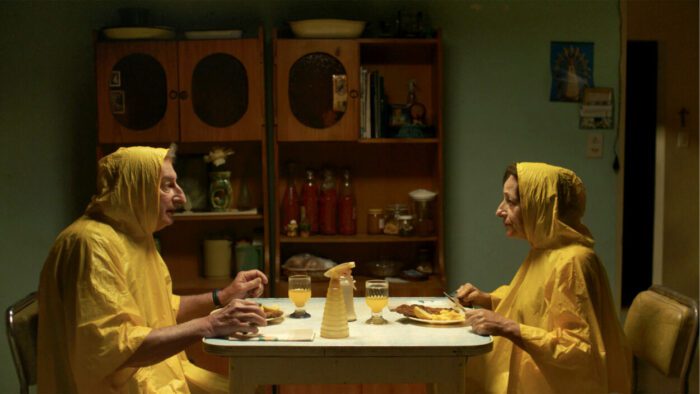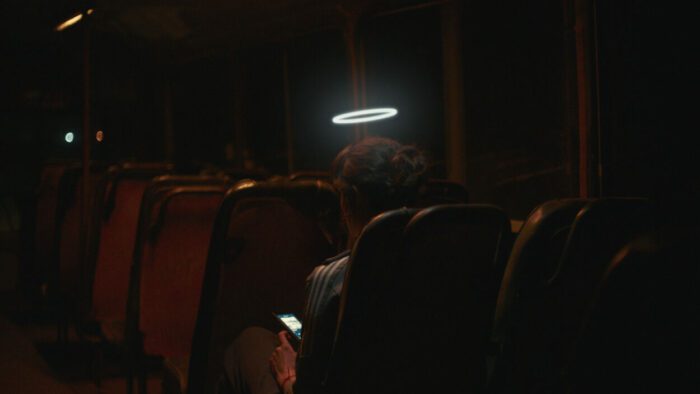Two years ago, Jordan Peele’s Nope posed a question to its audience: “What’s a bad miracle? They got a word for that?” For maybe as long as humanity has existed, people have been in search of a mystical answer that makes sense of our time on this planet. Some believe that the mysteries of the universe are revealed in religious texts or through art, and that a miracle will guide those in search of answers. In Tomás Gómez Bustillo’s lyrically absurd Chronicles of a Wandering Saint, the desire for a miracle is very real, but the miracle itself may not be as spontaneous as one might expect.
Rita (Mónica Villa) is a devoutly religious woman in a small, rural Argentinian town. Despite the fact that she has dedicated most of her life to the Church, a competitive streak runs through her. It’s this nature that inspires her to stage a miracle. Rita finds a long-forgotten statue in a church storage room and decides to pretend that it’s a statue that went missing decades ago. Along for the ride is her husband, Norberto (Horacio Marassi), even though he would much rather take Rita on a relaxing vacation. As Rita’s plan begins to come into focus, her life changes irrevocably.

Chronicles of a Wandering Saint has a tonal shift around the middle mark that provides one of the best out-of-left-field changes of perhaps any movie. What makes it so memorable is not the inciting incident itself, but how essential it is to the film’s story and structure. In lesser hands, it would come across as gimmicky or shocking, included simply for the sake of creating something for people to talk about. In the hands of Gómez Bustillo, the twist (for lack of a better word) tugs on the heartstrings of the audience and puts them on an unexpected path of reflection.
What elevates Chronicles of a Wandering Saint to, well, sainthood, is the masterful blend of the mundane and the absurd. Few films have cracked the code of exploring the truths of the human experience while embracing the weirdness that exists for all of us. Life is the strangest, and only, thing all of us will share, and try as we might to understand it, we’re merely along for the ride. The good comes with the bad, the strange with the boring, the love with the hate. Chronicles of a Wandering Saint presents a magical world that isn’t beyond our comprehension. Instead, the film asks its audience to pay attention to themselves and the people they love. To recognize that there is magic in the flickering of lights, in dogs, and in everything, they must pay attention.

We can hope and fight as much as we want, but time is constantly, relentlessly moving forward. We are not the same people we were twenty minutes ago, let alone twenty years ago. Rita finds herself in a state of stagnation that ultimately pushes her to create this faux-miracle in the hope of reigniting her life. Norberto tries to get her to remember their honeymoon from decades ago when they went to visit waterfalls. Rita has no time for reminiscing, nor any interest in returning. “The waterfalls are exactly the same,” she says. “Yes, but we are not,” Norberto replies. They’re both feeling the pull to change something about their lives, but choose to go about it in different ways. The world around us may not change as quickly as we do, but there are small, imperceptible marks of the passage of time.
Chronicles of a Wandering Saint is built on a perspective shift. One that literally happens at the film’s midpoint and also acts as the main takeaway from the movie itself. The mundane can be seen as a prison that one needs to break free from or, as the film argues, a place of comfort. The daily ins and outs of life are a gift, no matter how boring they may seem. The people we spend our time with, the hobbies we take up, and the way we choose to go about our days are all significant. They are within our grasp and should be cherished. The way to do that is a perspective shift like the one in Chronicles of a Wandering Saint. It’s a matter of making that change sooner rather than later. Chronicles of a Wandering Saint is a high-concept, humorous look at the miracles that exist in life and death, and an urgent attempt to have its audience embrace the present moment and everything that it is.



